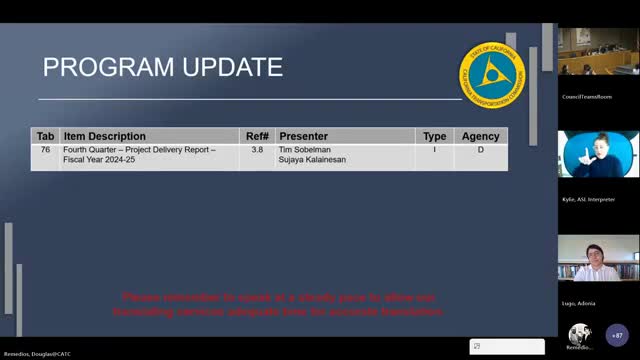Caltrans reports 83% fiscal‑year delivery and new risk‑reduction initiatives to CTC
October 20, 2025 | Transportation Commission, Agencies under Office of the Governor, Executive, California
This article was created by AI summarizing key points discussed. AI makes mistakes, so for full details and context, please refer to the video of the full meeting. Please report any errors so we can fix them. Report an error »

Caltrans reported to the California Transportation Commission that it achieved an 83% delivery rate for projects planned in fiscal year 2024–25 and outlined several continuous‑improvement initiatives intended to reduce schedule and cost risk across the state’s portfolio.
Sujaya Kalainesen, Caltrans Division Chief of Project Management, told commissioners the department had planned 250 projects for the fiscal year and delivered 207. The 83% figure includes projects carried over from prior years; excluding carryover projects yields a different percentage described in staff materials. Kalainesen said 88 projects were delivered in June, that 40% of the portfolio had been flagged with significant risks, and that the capital value delivered was roughly $4.4 billion compared with $4.8 billion planned.
Why it matters: the State Highway Operation and Protection Program (SHOP) and STIP projects make up a large share of the state’s transportation capital work. Delivery rates, the timing of allocations and the pace of construction affect both program capacity and regional schedules for completions and disbursements.
Caltrans described new and expanded practices to mitigate risk: a half‑day “high risk” workshop to drill into recurring risk drivers; a hands‑on project delivery training boot camp for new project managers and engineers; improved guidance for project delivery team meetings; and streamlined reporting mechanisms that emphasize early design to identify risks sooner. Kalainesen said the department will use collaborative project management board meetings across divisions and districts to address cross‑cutting risk buckets such as right‑of‑way and utility coordination.
Caltrans staff also noted a higher‑than‑normal rate of bidding savings and an evolving allocation capacity target; commission staff and Caltrans said they formed an executive team to track SHOP capacity and to propose short‑ and long‑term approaches if current trends continue. Caltrans reported it received about $300 million in federal emergency relief reimbursements during FY 2024–25 related to major damage and emergency projects.
Commissioners welcomed the update and congratulated Caltrans on progress while asking staff and Caltrans to keep the commission apprised of allocation‑capacity plans and any adjustments needed to avoid a rolling backlog of projects. There was no public comment on the item.
Caltrans highlighted the department’s first‑quarter snapshot for FY 2025–26: 228 projects programmed in the portfolio, with 138 showing identified risk at low/medium/high levels and a total capital dollar plan of about $5.8 billion across multiple fund sources. The agency said it will aim to accelerate milestone completions earlier in the fiscal year instead of concentrating too many allocations in the final month.
Sujaya Kalainesen, Caltrans Division Chief of Project Management, told commissioners the department had planned 250 projects for the fiscal year and delivered 207. The 83% figure includes projects carried over from prior years; excluding carryover projects yields a different percentage described in staff materials. Kalainesen said 88 projects were delivered in June, that 40% of the portfolio had been flagged with significant risks, and that the capital value delivered was roughly $4.4 billion compared with $4.8 billion planned.
Why it matters: the State Highway Operation and Protection Program (SHOP) and STIP projects make up a large share of the state’s transportation capital work. Delivery rates, the timing of allocations and the pace of construction affect both program capacity and regional schedules for completions and disbursements.
Caltrans described new and expanded practices to mitigate risk: a half‑day “high risk” workshop to drill into recurring risk drivers; a hands‑on project delivery training boot camp for new project managers and engineers; improved guidance for project delivery team meetings; and streamlined reporting mechanisms that emphasize early design to identify risks sooner. Kalainesen said the department will use collaborative project management board meetings across divisions and districts to address cross‑cutting risk buckets such as right‑of‑way and utility coordination.
Caltrans staff also noted a higher‑than‑normal rate of bidding savings and an evolving allocation capacity target; commission staff and Caltrans said they formed an executive team to track SHOP capacity and to propose short‑ and long‑term approaches if current trends continue. Caltrans reported it received about $300 million in federal emergency relief reimbursements during FY 2024–25 related to major damage and emergency projects.
Commissioners welcomed the update and congratulated Caltrans on progress while asking staff and Caltrans to keep the commission apprised of allocation‑capacity plans and any adjustments needed to avoid a rolling backlog of projects. There was no public comment on the item.
Caltrans highlighted the department’s first‑quarter snapshot for FY 2025–26: 228 projects programmed in the portfolio, with 138 showing identified risk at low/medium/high levels and a total capital dollar plan of about $5.8 billion across multiple fund sources. The agency said it will aim to accelerate milestone completions earlier in the fiscal year instead of concentrating too many allocations in the final month.
View full meeting
This article is based on a recent meeting—watch the full video and explore the complete transcript for deeper insights into the discussion.
View full meeting
